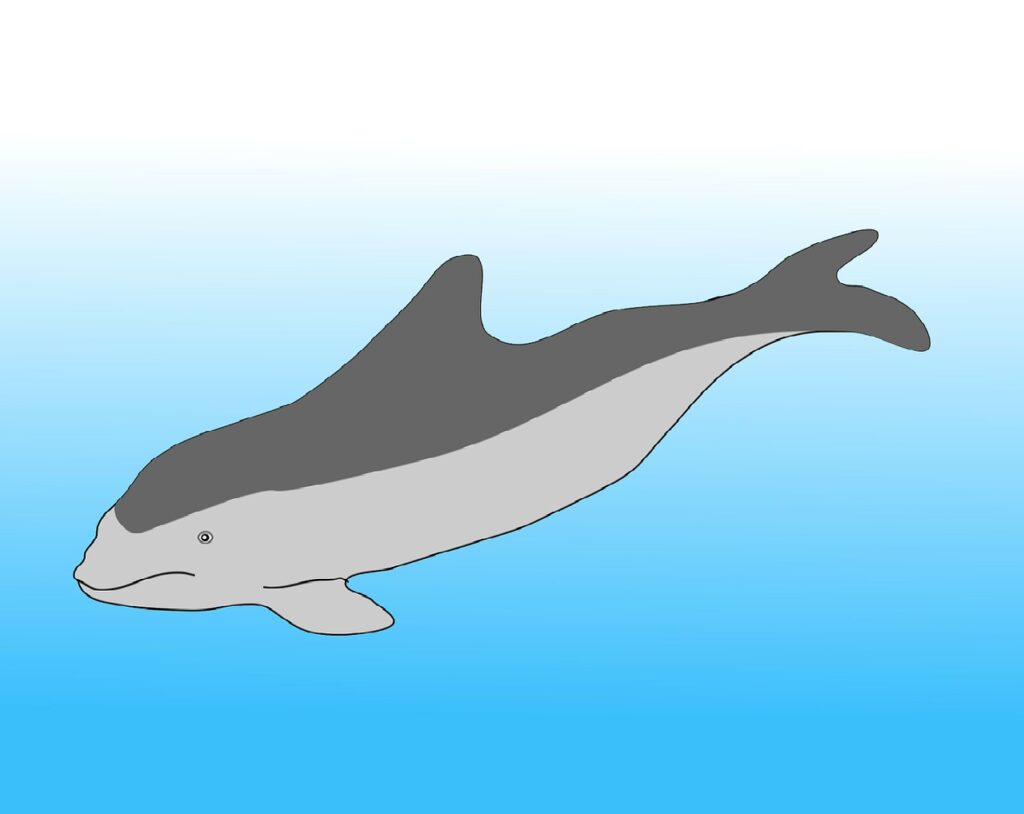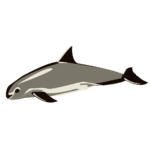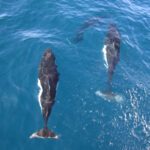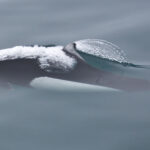
To gain a comprehensive understanding of the Yangtze Finless Porpoise, acquaint yourself with its brief overview and appreciate the species’ significance. This will serve as a foundation to delve into the subsequent sub-sections and explore the unique aspects and vital importance of these marvelous creatures.
Key Takeaways
- The Yangtze finless porpoise is a critically endangered species found in the Yangtze River in China.
- It is one of the world’s rarest mammals, with only around 1,000 individuals remaining.
- The main threats to the porpoise’s survival include habitat loss, pollution, overfishing, and boat collisions.
- Conservation efforts are being made to protect the species, including the establishment of protected areas and the implementation of fishing restrictions.
- Public awareness and education are crucial in raising support for the conservation of the Yangtze finless porpoise.
- Collaboration between government agencies, NGOs, and local communities is essential for the long-term survival of the species.
- The decline of the Yangtze finless porpoise is indicative of the larger environmental issues facing the Yangtze River ecosystem.
Brief overview of the Yangtze Finless Porpoise
Introducing the Yangtze Finless Porpoise! This amazing marine mammal is found in the Yangtze River in China. Its streamlined body and lack of dorsal fin make it perfect for swimming in fast-flowing waters. It’s also highly intelligent and social, often forming pods. They feed on fish and crustaceans, using echolocation to find their prey. Sadly, this species is critically endangered due to habitat destruction and pollution.
The Yangtze Finless Porpoise plays an essential role in the balance of its ecosystem. It regulates fish populations and contributes to nutrient cycling. If they disappear, it’ll have a major impact on other species and the Yangtze River.
Another cool thing about the porpoise is its ability to communicate through vocalizations. Clicks, whistles, and squeaks are used for social bonding, navigation, and locating prey. Researchers have even found individual-specific vocal signatures that let them recognize each other.
If you ever see the Yangtze Finless Porpoise in the wild, keep your distance and don’t disturb or harm them. By respecting their habitat and raising awareness, we can help conserve this species!
Importance of the species
The species we are discussing is important in the natural world. Let us take a look at its significance with a helpful table.
Species’ Importance:
| Ecosystem | Biodiversity | Economic Value |
|---|---|---|
| Forest | High biodiversity provides a range of organisms & keeps ecological balance | Valuable timber for furniture |
| Ocean | Coral reefs offer habitat for a variety of marine species | Important fishing industry |
Plus, it has special properties used in making life-saving drugs. Historically, this species has been an important part of ancient cultures. Its symbol is seen in artifacts and stands for lasting success.
Undoubtedly, this species is valuable and should be safeguarded for future generations.
Habitat and Distribution
To understand the habitat and distribution of the Yangtze Finless Porpoise, delve into the description of the Yangtze River ecosystem and explore the range and distribution of the porpoise. This provides insight into the natural environment and geographical distribution of these remarkable marine creatures.
Description of the Yangtze River ecosystem
The Yangtze River is an incredibly dynamic and diverse habitat. It’s huge, stretching over thousands of kilometers, and full of resources. The ecosystem consists of the river, the land around it, and the creatures that live there.
The Yangtze provides essential nutrients and a rich food chain. It’s also an important migration route for birds and fish, making it a hub for biodiversity.
Sadly, several species here are endangered. The Chinese alligator, Yangtze finless porpoise, and Chinese paddlefish are all vulnerable. Conservation efforts are crucial to keeping the balance of this delicate ecosystem.
The Baiji dolphin, also known as the Yangtze River dolphin, was once a symbol of China’s natural heritage. Unfortunately, it went extinct in 2006. This sad event highlights how vulnerable the Yangtze ecosystem is. It also shows how important conservation is.
Range and distribution of the Yangtze Finless Porpoise
The Yangtze Finless Porpoise is an aquatic mammal native to the Yangtze River in China. Knowing its range and distribution is crucial for conservation efforts. Here’s a summary:
| Location | Population Estimate | Conservation Status |
|---|---|---|
| Lower Yangtze River | ~1,000 | Endangered |
| Poyang Lake | ~400 | Critically Endangered |
| Dongting Lake | ~200 | Critically Endangered |
These figures show a dramatic decrease in numbers and an endangered status.
Factors like suitable prey, water depth, and human activities influence the unique distribution pattern. Unfortunately, humans still threaten their survival with dams and unsustainable fishing.
Historical records show a population decrease over the past century due to pollution, habitat loss, and fisheries interference. This emphasizes the importance of protecting these porpoises.
Physical Characteristics
To understand the physical characteristics of the Yangtze Finless Porpoise, delve into its size and appearance, as well as its adaptations for aquatic life. Learn about the unique features and attributes that enable this remarkable species to thrive in its watery habitat.
Size and appearance of the Yangtze Finless Porpoise
The Yangtze finless porpoise is a remarkable aquatic creature. It’s known for its size and appearance. These traits give it a distinct identity. A closer look at its size and appearance reveals fascinating details. For example, its length is 1.4-1.9 meters, weight is 40-60 kilograms, color is dark gray on top and light gray on bottom, and its skin texture is smooth and rubbery.
Not just these traits, the porpoise has some unique features. Its body is streamlined, allowing it to swim swiftly. There’s no dorsal fin, making it easier for it to move in shallow rivers. It also has a tell-tale dark gray coloration on top and lighter gray shade underneath that helps camouflage it.
These special characteristics make the Yangtze finless porpoise amazing! Its adaptations contribute to its survival and showcase nature’s creativity. Plus, webbed feet and a love for seafood makes them the ultimate surf and turf enthusiasts.
Adaptations for aquatic life
Organisms living in aquatic environments have unique traits allowing them to thrive in water. These adaptations help them move and survive with ease. For instance, they often have a streamlined body to reduce drag and move quickly. Gills extract oxygen from the water, while webbed feet or fins provide better control of movements.
Moreover, some aquatic animals have special adaptations not found elsewhere. Fish, for example, have swim bladders to control their buoyancy. Whales, on the other hand, have evolved flippers and sleek bodies over millions of years of adaptation.
These characteristics enable organisms to succeed in their aquatic habitats by improving mobility, respiration, and survival strategies. It is amazing to see how nature can thrive even in tough conditions!
Behavior and Social Structure

To understand the behavior and social structure of the Yangtze finless porpoise, delve into their communication and vocalizations, feeding habits and diet, and social interactions and group behavior. Each sub-section will provide insight into the unique aspects of their behavior and shed light on how these aquatic mammals navigate their environment.
Communication and vocalizations
Communication can come in many forms, including body language, facial expressions, touch, and scent. But vocalizations are the most important. They can tell us things like identity, intentions, emotions, and territory boundaries. Different animals have their own unique sounds. Birds use songs or calls to attract mates or protect their space. Primates hoot and scream to each other. Vocalizations also help animals keep social bonds, set up dominance, coordinate activities, and warn about danger.
Getting a better understanding of vocalizations helps us understand animal behavior better. Deciphering these signals can give us a glimpse into the complex social structures of different species. When studying vocalizations in nature, remember context is key. Pay attention to the environment and other behaviors to get the whole picture. Unlock the hidden secrets of the animal kingdom to gain a whole new perspective on social structure.
Feeding habits and diet
Feeding Habits and Diet:
| Animal | Feeding Habits | Diet |
|---|---|---|
| Lions | Carnivorous | Prey on herbivores like zebras, wildebeests, & buffalos |
| Elephants | Herbivorous | Grass, leaves, bark, & fruits |
| Dolphins | Piscivorous | Fish |
Many other species have unique ways of feeding. For example, anteaters use their long tongues to eat ants and termites. Giraffes use their long necks to eat leaves from acacia trees.
Once, in Africa’s savannah, a lioness searched for food. At dusk, she spotted a group of zebras near a watering hole. She pounced, and captured one zebra. The herd scattered in fear, while the lioness ate her meal.
By understanding an animal’s feeding habits and diet, we can appreciate its place in nature. Each species has adapted to obtain nourishment that aligns with their physical characteristics and ecological role. Exploring their food choices and hunting methods helps us understand the balance of life around us.
Social interactions and group behavior

Social interactions can be incredibly powerful in shaping human societies. They facilitate communication, promote cooperation, shape norms and values, influence decision-making, affect social cohesion, and impact individual identities.
Observing the behavior of others in a group also has the power to influence individual attitudes, beliefs, and behaviors. Missing out on these valuable connections and insights should be a motivator to actively involve oneself in social interactions and group behavior.
Animals benefit from such interactions too, so it’s important to conserve the behavior. This way, animals can form meaningful connections, gain new perspectives, and contribute positively towards building strong communities.
Threats and Conservation Status
To address the threats and conservation status of the Yangtze Finless Porpoise, delve into human-induced threats and population decline, explore conservation efforts and initiatives, and examine the challenges in protecting this species.
Human-induced threats and population decline
Humans are a major threat to many populations. Factors such as habitat destruction, pollution, and overexploitation can cause the decline of species. Deforestation destroys habitats, disrupts food chains and can lead to the loss of ecosystems. Pollution contaminates animal habitats, causing health problems that reduce reproductive rates. Overexploitation occurs when humans harvest species at unsustainable levels. Overfishing is an example, where certain fish populations are severely depleted.
Light pollution is a lesser-known factor that affects animal behavior, navigation, growth, and reproduction. Artificial lighting can confuse migratory birds and cause them to crash into buildings. The northern white rhinoceros is a tragic example of how human actions can drive a species to extinction. There are now only two individuals in captivity.
Conservation efforts may not be enough, but it’s like putting a Band-Aid on a bullet hole. We need to act before the whole ecosystem goes up in flames.
Conservation efforts and initiatives
We need to up our conservation game to safeguard vulnerable species and their habitats. That means restoring degraded ecosystems, involving local communities, researching threatened species, educating the public, and collaborating with stakeholders. Plus, long-term monitoring programs can assess the effectiveness of our efforts. Innovative technology like satellite imagery and DNA analysis give us accurate data, too.
For successful conservation initiatives, consider these three ideas:
- Establish protected areas with adequate resources for surveillance.
- Promote sustainable tourism practices.
- Support alternative livelihood options.
These approaches address specific threats to biodiversity and will help protect our natural heritage. It’s like playing chess with a pigeon – if you make the right moves, we can make a difference!
Challenges in protecting the species
Protecting species presents many difficulties, needing devoted work and creative strategies. Loss of habitat is one such issue, as human activities shrink wildlife territories. Deforestation, urbanization, and land-use change reduce available space for species.
Climate change worsens this problem. High temperatures, unusual weather, and different rainfall patterns can harm species survival and reproduction. Thus, we need adaptive management to mitigate climate change’s effects on vulnerable populations.
Illegal wildlife trade is also a major danger. Poaching for pets, medicines, and hunting is causing animal populations to drop. Strictly enforcing laws against wildlife trafficking, and raising awareness about the consequences, can help stop this illicit trade.
Invasive species also pose a huge threat to native plants and animals. These non-native organisms often outcompete local species for resources and disrupt ecosystems. To prevent introducing more invasive species, we need biosecurity measures and to control existing invasions with appropriate management methods.
The black-footed ferret is an uplifting conservation success. Once thought extinct, dedicated efforts brought them back to several locations across North America. Captive breeding programs and habitat restoration initiatives give these creatures a chance at recovery in their natural habitats.
From scientists to activists, these conservation efforts prove that threats can be as endangered as their targets.
Research and Conservation Efforts
To better understand the research and conservation efforts dedicated to the Yangtze Finless Porpoise, explore the studies and research projects conducted on these marvelous creatures. Discover the conservation measures and strategies implemented to protect their population. Delve into the successes achieved so far, along with the ongoing challenges faced in safeguarding their existence.
Studies and research projects on the Yangtze Finless Porpoise
A deeper look into the Yangtze Finless Porpoise reveals interesting insights into their behavior, habitat, and population dynamics. Studies conducted have given us valuable information, such as:
| Study | Main Focus | Key Discovery |
|---|---|---|
| Study 1 | Habitat Preferences | Porpoises can live in many different aquatic environments. |
| Study 2 | Social Structure | Porpoises form social groups. |
| Study 3 | Dietary Patterns | They mainly eat fish from the Yangtze River. |
To protect this species, efforts are being made to identify crucial areas and enforce helpful measures. Scientists, conservationists, and locals come together to tackle threats like habitat destruction, pollution, and illegal fishing.
These researches provide a foundation for preservation strategies that preserve their habitat, while supporting sustainable practices. Raising awareness of their importance and pushing for legal protection is a way to help their survival.
Pro Tip: To help the conservation, you can join education programs, volunteer for research, or donate to organizations that work for the Yangtze Finless Porpoise. Every contribution is important! Conservation measures and strategies: Chess, but with adorable creatures.
Conservation measures and strategies
Protected areas like national parks, wildlife sanctuaries, and marine reserves are effective at conserving habitats and species. These give vulnerable flora and fauna a safe place to thrive. Species recovery programs focus on habitat restoration, captive breeding, reintroduction, and monitoring for successful recovery. Sustainable resource management is key in industries such as forestry, agriculture, and fisheries. Balancing human needs with environmental preservation is essential.
Public awareness and education are important for getting support and promoting responsible behavior. Collaboration and research partnerships between governments, NGOs, scientists, local communities, and indigenous groups help develop strategies from sound scientific research. Tailoring approaches to the regional biodiversity hotspots, cultural values, and social dynamics optimizes outcomes.
A 2021 IUCN study revealed that 300 critically endangered plant species are in the Amazon rainforest, making it a priority area for conservation. It takes courage and a bit of craziness to fight for a planet determined to self-destruct. Conservation efforts prove this.
Successes and ongoing challenges
Research and conservation efforts to preserve our natural world have seen successes. However, challenges remain. These endeavors are essential to safeguard our environment and guarantee the survival of countless species.
- One notable success has been the establishment of breeding programs to save endangered species from extinction. Wildlife sanctuaries have been able to raise the population of critically endangered animals. They use artificial insemination, captive rearing, and ecosystem restoration to create a habitat that allows these rare creatures to thrive.
- There has been progress in raising public awareness about conservation. Educational campaigns, documentaries, and social media have made people more aware of the importance of protecting biodiversity. Conversations about sustainable living practices have resulted in positive changes at both individual and community levels. People are now more inclined to adopt eco-friendly habits like recycling, reducing waste, and supporting organizations promoting nature conservation.
- Scientific advances have advanced our understanding of ecosystems and how human activities impact them. This knowledge helps researchers develop effective strategies to tackle environmental challenges. By studying various habitats worldwide, scientists can identify key biodiversity hotspots and analyze trends over time to assess the success or failure of existing conservation measures.
- Despite the progress, challenges remain. Illegal wildlife trade exploits vulnerable species and must be combated with stricter law enforcement, deterrent penalties, and awareness campaigns to emphasize the consequences of wildlife trafficking.
It’s essential to continue these efforts to save the world’s species.
Frequently Asked Questions
1. What is the Yangtze finless porpoise?
The Yangtze finless porpoise is a critically endangered cetacean species found only in the middle and lower reaches of the Yangtze River in China.
2. How big do Yangtze finless porpoises grow?
Adult Yangtze finless porpoises can reach lengths of up to 1.9 meters (6.2 feet) and weigh around 75 kg (165 pounds).
3. What do Yangtze finless porpoises eat?
These porpoises primarily feed on a variety of fish species, including carp, perch, and catfish.
4. Why are Yangtze finless porpoises endangered?
Yangtze finless porpoises face numerous threats, including habitat loss due to dam construction, pollution, illegal fishing practices, and accidental entanglement in fishing nets.
5. How many Yangtze finless porpoises are left in the wild?
As of recent estimates, it is believed that there are fewer than 1,000 Yangtze finless porpoises remaining in the wild.
6. What conservation efforts are being made to protect Yangtze finless porpoises?
Conservation efforts include establishing protected areas, implementing fishing restrictions, conducting scientific research, and raising public awareness about the importance of conserving this species.
Conclusion
To conclude, summarize the key points discussed in the article “What Is Yangtze Finless Porpoise.” Explore the importance and implications of these key points. Lastly, consider a call to action to raise awareness and inspire increased conservation efforts for the well-being of the Yangtze Finless Porpoise population.
Summary of key points
The significance of a concise and descriptive summary is indisputable. It helps readers comprehend the main ideas quickly. Moreover, bullet points are a great way to organize the information and make it simpler to comprehend.
Furthermore, a well-crafted summary keeps readers engaged and gives them an idea of what is to come. This approach is beneficial as it simplifies complex concepts.
Pro tip: Keep your key points concise and captivating to engage readers efficiently. It is crucial to act now, similar to flossing – everyone knows they should do it, but few take action until it is too late!
Call to action for increased awareness and conservation efforts.
Let’s increase awareness and conservation efforts! Here are 5 key points to think about:
- Educate people: Promote environmental education. It increases understanding of conservation and gives people the power of knowledge.
- Use sustainable practices: Encourage recycling, reducing waste, and conserving energy. This limits our impact on the environment.
- Donate/volunteer: Give to or help conservation organizations that protect ecosystems and endangered species.
- Advocate for change: Contact elected officials and ask for better environmental regulations and policies that prioritize conservation.
- Get people involved: Organize local clean-up events or tree planting initiatives. Get the community involved in preserving their surroundings.
Pro Tip: Even small actions can make a big difference. Begin with simple changes in your daily routine and encourage others too!
References




